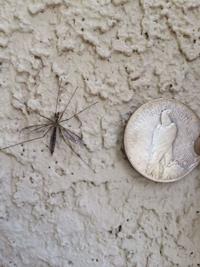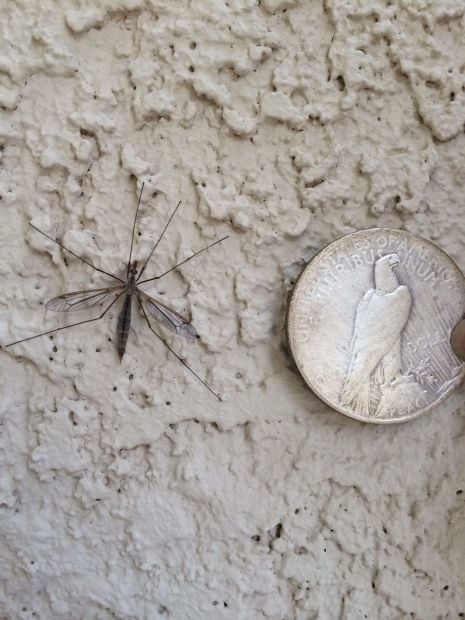The giant mosquito-like insects that have swarmed Tucson now are not actually mosquitoes, or spiders, and are not really that uncommon for this area after a wet winter.
Crane flies typically spend much of their lives in a larval stage, but when there is a wet winter, with plenty of damp soil, they will emerge as adults. You’ll see them hanging around outdoor lights and windows and clinging to walls, and pretty much live to mate and lay eggs, a UA expert says.
They are harmless and don’t bite, according to Michael Bogan, assistant professor of aquatic biology at the University of Arizona School of Natural Resources.
Bogan answered some questions, courtesy of the UA News, about the abundance of crane flies seen around Tucson:
Q: What are crane flies?
A: Crane flies make up a large family — Tipulidae — in the order Diptera, or true flies, and as such they’re related to other true flies, like mosquitoes and robber flies. Luckily for us, though, they don’t bite. Most of the 15,000-plus species of crane flies in the world spend the larval part of their life living in water bodies, such as rivers and lakes, piles of wet leaves or in damp soil. About 95% of their life is spent in this larval stage, and it can last as long as three years or more. During this time as larvae, crane flies are important for recycling and decomposition — they eat leaves, plants and small bits of organic material in the soil or water bodies where they live. Occasionally, they can reach high densities in flooded fields, pastures or heavily watered lawns, and become a bit of a pest to someone trying to maintain a perfect lawn. However, when they transform into their adult stage — the one we’re seeing around Tucson now – pretty much all they do is look for a mate and lay eggs.
Q: Why are they showing up in great numbers in Tucson?
A: The heavy rains we had in November helped to wet the soil in Tucson, which triggers more activity in crane fly larvae. We continued to get rains in December and January, and lots of wildflowers and grasses have been growing around town the last couple months, so all of that growth provides good food for crane fly larvae. The larvae grow fastest under moist soil conditions with good food resources, so they’ve developed quickly in our urban soils and are now transforming into adult crane flies and taking to the skies around town.
Q: Is this mass occurrence unusual in any way?
A: This year’s mass emergence or irruption of crane flies is not unusual at all. In fact, we had similar irruptions in Tucson during the wet winters of 2010, 2015 and 2017. There’s no data to suggest this year’s mass emergence is any different from past winters with good rainfall and wildflowers.
Q: Is there any reason people need to be concerned?
A: Nope, no reason for concern. In fact, people should be happy that our birds, bats and other urban wildlife have so much food to eat this winter, in the form of crane flies. The adults, like many insects, are attracted to lights and so they end up on our front porches at night and fly into the house when doors and windows are open. But they don’t cause any harm and don’t carry any diseases.
Q: How often should we expect a mass occurrence of crane flies?
A: Any time we have heavy rains in the fall and winter, especially a heavy rain followed by several other storms, which ensure that the soil stays wet for a couple months at least.
Q: Why is it the crane flies we see around the house appear to be doing absolutely nothing?
A: Nearly 100% of the energy that crane fly adults have comes from the food they ate as larvae — the adults don’t eat any food at all. Imagine if we stopped eating food at age 18, and had to get by our entire adult lives on the food we ate as children. Similarly, crane flies have to conserve their limited energy resources and just hang out doing nothing quite a lot. But when they see potential mates or good places to lay their eggs after mating, then they’ll spring into action and fly around.





